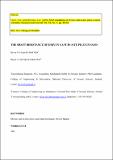| dc.contributor.author | Flynn, Kevin N. | |
| dc.contributor.author | McCabe, Bryan A. | |
| dc.date.accessioned | 2017-02-13T16:33:47Z | |
| dc.date.available | 2017-02-13T16:33:47Z | |
| dc.date.issued | 2015-06-25 | |
| dc.identifier.citation | Flynn, Kevin N., & McCabe, Bryan A. (2015). Shaft resistance of driven cast-in-situ piles in sand. Canadian Geotechnical Journal, 53(1), 49-59. doi: 10.1139/cgj-2015-0032 | en_IE |
| dc.identifier.issn | 1208-6010 | |
| dc.identifier.uri | http://hdl.handle.net/10379/6297 | |
| dc.description.abstract | Driven cast-in-situ (DCIS) piles are classified as a large displacement pile, despite sharing certain aspects of their construction with replacement pile types. However, there are relatively few case histories of load tests on DCIS piles in the literature to verify the assumption that they behave as large displacement piles. In particular, the shaft resistance of DCIS piles in sand is uncertain due to the complex interaction between the freshly cast concrete and surrounding displaced soil after extraction of the steel installation tube. This paper describes the installation, curing, and maintained compression load testing of three temporary-cased DCIS test piles at a uniform sand site near Coventry, United Kingdom. The piles were instrumented with vibrating wire strain gauges to enable accurate measurement of the local shear stress generated on the pile shaft during maintained compression loading. The tests showed that the peak average and local shear stresses tended to mobilize at greater shaft displacements than traditional preformed displacement piles during loading. A clear reduction in normalized local shear stresses (and hence radial effective stress) at failure with distance from the pile base, i.e., friction fatigue, was evident for all piles, implying that radial stresses generated during driven installation of the steel tube are not erased upon concreting and tube withdrawal. Furthermore, the inferred normalized radial effective stresses at failure were remarkably similar to those reported for traditional preformed displacement piles in the literature. | en_IE |
| dc.description.sponsorship | The financial assistance provided to the first author by the College of Engineering & Informatics Research Fellowship and University Foundation Bursary is also gratefully acknowledged. | en_IE |
| dc.format | application/pdf | en_IE |
| dc.language.iso | en | en_IE |
| dc.publisher | NRC Research Press | en_IE |
| dc.relation.ispartof | Canadian Geotechnical Journal | en |
| dc.rights | Attribution-NonCommercial-NoDerivs 3.0 Ireland | |
| dc.rights.uri | https://creativecommons.org/licenses/by-nc-nd/3.0/ie/ | |
| dc.subject | Civil engineering | en_IE |
| dc.subject | Driven | en_IE |
| dc.subject | Cast-in-situ | en_IE |
| dc.subject | Piles | en_IE |
| dc.subject | Sand | en_IE |
| dc.subject | Shaft resistance | en_IE |
| dc.subject | Friction fatigue | en_IE |
| dc.subject | Displacement piles | en_IE |
| dc.subject | Dense sand | en_IE |
| dc.subject | Capacity | en_IE |
| dc.subject | Design | en_IE |
| dc.subject | Load | en_IE |
| dc.title | Shaft resistance of driven cast-in-situ piles in sand | en_IE |
| dc.type | Article | en_IE |
| dc.date.updated | 2017-02-09T11:43:55Z | |
| dc.identifier.doi | 10.1139/cgj-2015-0032 | |
| dc.local.publishedsource | http://dx.doi.org/10.1139/cgj-2015-0032 | en_IE |
| dc.description.peer-reviewed | peer-reviewed | |
| dc.contributor.funder | |~|1267880|~| | |
| dc.internal.rssid | 10710226 | |
| dc.local.contact | Bryan Mccabe, Dept. Of Civil Engineering, Coll Engineering & Informatics, Room Eng-1040, Nui Galway. 2021 Email: bryan.mccabe@nuigalway.ie | |
| dc.local.copyrightchecked | No | |
| dc.local.version | ACCEPTED | |
| nui.item.downloads | 836 | |


